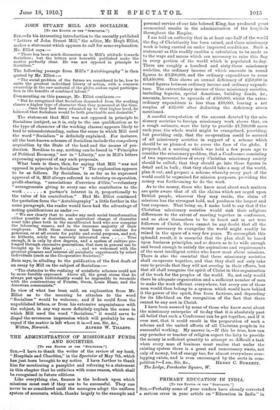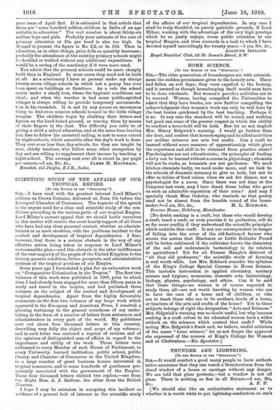PRIMARY EDUCATION IN INDIA.
[TO THN EDITOR 07 THY "SPECTATOR."]
Srn,—Probably some of your readers have already corrected a serious error in your article on "Education in India" in your issue of April 2nd. It is estimated in that article that there are " some hundred million children in India of an age suitable to education." The real number is about thirty-six million boys and girls. Probably your estimate of the cost of primary education at 10s. per head is also too high. In Bengal at present the figure is Rs. 2/2, or 2s. 10d. Then in education, as in other things, price falls as quantity increases; probably the attendance at the existing primary schools might ba doubled or trebled without any additional expenditure. It would be a saving of the machinery if it were more used.
You admit that the primary schools could be more cheaply built than in England. In most cases they need not be built at all. As a missionary I have at present under my charge twenty-seven village schools in which not a penny has ever b3en spent on buildings or furniture. As a rule the school meets under a shady tree, where the hygienic conditions are ideal ; and when the weather is bad some public-spirited -villager is always willing to provide temporary accommoda- tion in his verandah. It is not by any means an uncommon thing to find even mission schools housed in the little village temples. The children begin by chalking their letters and figures on the hard-baked ground, or tracing them by means of their fingers in the dust. The difficulty you refer to of giving a child a school education, and at the same time leaving him free to follow his ancestral calling, is met to some extent by night-schools, which assemble after the day's work is done. They cost even less than day-schools, for they are taught by men, chiefly teachers, who follow some other occupation by day and are willing to supplement their income by teaching a night-school. The average cost over all is about ls. per pupil Bamdah, via Jhajha, India.











































 Previous page
Previous page